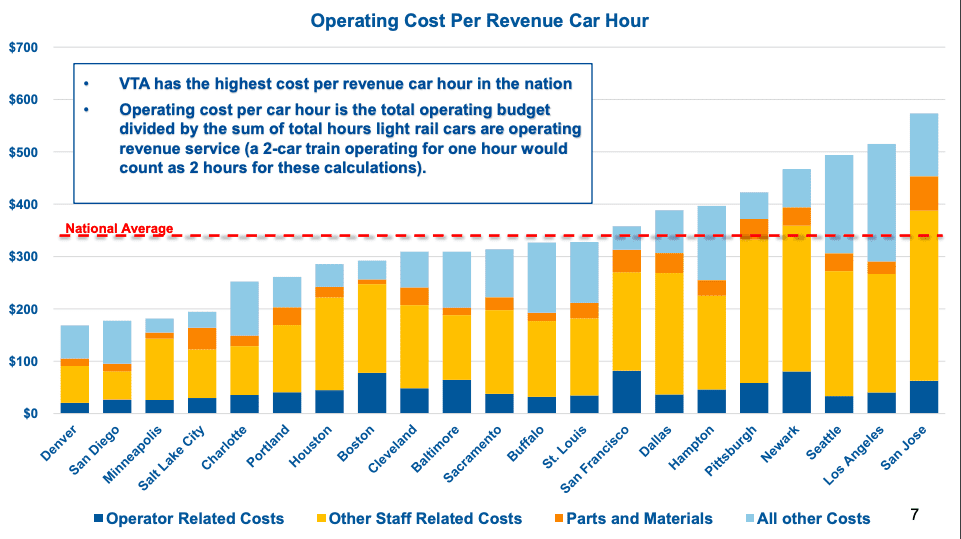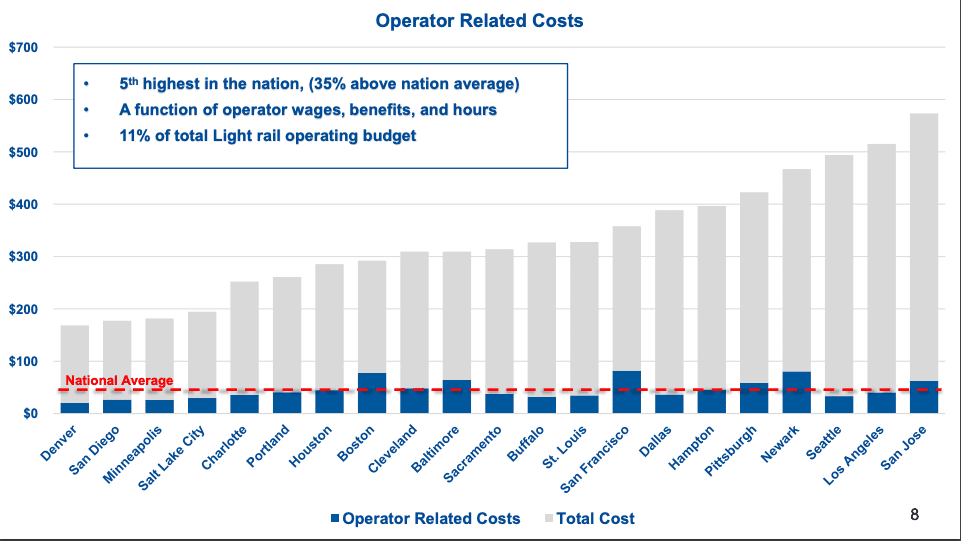VTA is pondering the future of its light rail system as it considers how to replace an aging fleet of train cars.
The public transit agency’s board of directors met last week to hear about the future of its light rail fleet. According to officials, VTA should replace its fleet of cars in three to seven years. As the agency considers how to do this, it’s also looking to reduce operating costs of the light rail system, which is high compared to other cities.
During the meeting, some board members questioned whether the agency should take a step back and examine bigger structural issues with light rail, such as VTA’s low ridership numbers and the struggle to bring riders to job centers in Silicon Valley.
“Are we riding the right horse here?” asked Mayor Sam Liccardo, who raised several concerns about costs. “I think we need to ask bigger questions because marginal improvements aren’t going to change this picture at all.”
VTA light rail was shut down for several months last year following a shooting at the Guadalupe rail yard on May 26. The agency offered riders a bus bridge service until light rail was restored in September. VTA, which saw a dramatic drop in riders at the onset of the pandemic, is still struggling to bring back passengers.
Last year, the agency projected expenses to exceed revenues by $6.9 million in fiscal year 2022, and that gap is expected to grow over the next decade to reach $47.5 million by 2031. The pandemic has contributed to the financial shortfall by triggering a decline in revenue from fares.
The highest operating costs
According to pre-pandemic data presented by VTA senior planner Jason Kim, VTA has the highest operating cost per revenue car hour in the nation.
VTA’s cost per revenue car hour is nearly $600. The next highest in the country is Los Angeles, which is a little over $500, according to data presented by Kim.


The operator costs of VTA are the fifth highest in the nation and 35% higher than the national average, he added. Per hour, it costs three times more to run light rail than a bus; in other agencies, the ratio is closer to two to one. VTA’s costs for parts and materials on light rail are the highest in the country.
Officials considered one alternative that would involve essentially replacing all 81 miles of light trail track with bus routes. VTA estimated this option wouldn’t provide a return on investment for about 60 years due to the high cost of replacing track with concrete.


A more realistic goal is to stretch the lifespan of the rail cars by operating a higher percentage of single-car trains and shortening the periods when they’re in service, which Kim said will reduce wear and tear.
General manager and CEO Carolyn Gonot said the agency created a parts and materials task force to examine how to bring down those expenses. She noted VTA is exploring emerging technologies that could bring other costs down, but that is a longer-term solution.
“There’s no newer technology right now that could operate over the entire system,” Gonot said.
Planning light rail’s future
Sunnyvale Councilmember and VTA board member Glenn Hendricks urged officials to stay in communication with cities serviced by light rail before considering any changes that could affect public transit. He noted Sunnyvale is examining putting 20,000 homes in the Moffett Park area, partly because light rail is nearby.
“I would hate to be in a spot where Sunnyvale’s planning for a lot of housing near light rail and then all of a sudden light rail service is not what we thought it was going to be,” he said.
To some extent the future of light rail will be determined by other transit infrastructure projects, such as the BART extension and Caltrain electrification. Connecting light rail to these projects could theoretically make it more attractive to riders, Gonot said. Milpitas Vice Mayor and VTA board member Carmen Montano argued speeding up light rail is the most critical factor in attracting new riders.
“People’s time is important, and people don’t want to waste their time being on the road,” Montano said.
Gonot pointed out VTA has one of the higher average speeds for its cars, although she acknowledged it feels slow in the downtown area. The agency wants to analyze how to improve speed in key segments of the light rail system, such as downtown San Jose and the tracks servicing the area south of the Milpitas BART connection.
Liccardo said he wasn’t satisfied with the agency’s focus. He noted VTA faces longer-term problems that need to be discussed sooner than later, such as integrating autonomous technology without displacing workers.
“I’m concerned we’re focusing on the small questions right now,” Liccardo said.
Monica Mallon, a transit advocate and San José Spotlight columnist, said the VTA board has been divided about the future of light rail for years. She noted Liccardo, who is skeptical of light rail, is going to be replaced by a new mayor later this year, which could significantly impact future discussions.
“If there is a San Jose mayor who is really for light rail, that’s going to change things,” Mallon said.
Contact Eli Wolfe at [email protected] or @EliWolfe4 on Twitter.



Leave a Reply
You must be logged in to post a comment.